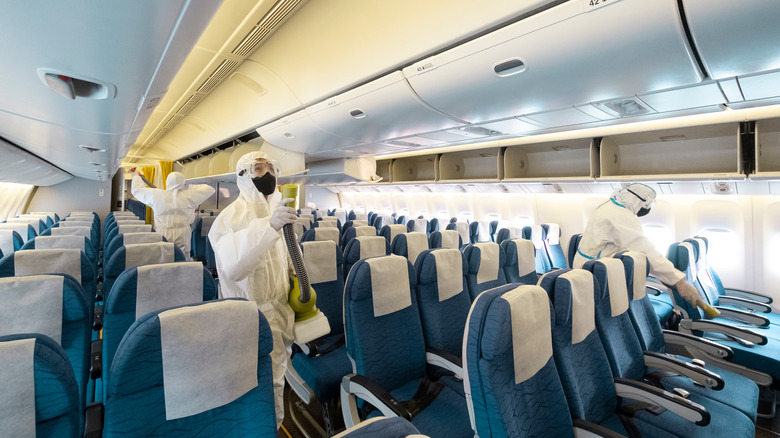Why You Should Think Twice Before Using The Overhead Air Vents On Airplanes
Concern about airplane cleanliness is one of the many stressful parts of traveling and the COVID-19 pandemic has added all-new levels of apprehension and uneasiness to the entire process. In 2015, Travel Math sent a microbiologist to collect samples from four different airplanes and five different airports to determine the dirtiest surfaces encountered during air travel. The samples went to a lab where scientists estimated the total bacteria population, or "colony forming units (CFU)," per square inch. The "winner" by far was tray tables, which were found to have 2,155 CFU per square inch. Per Forbes, airline staff do a quick clean-up of the cabin of the plane between flights but don't usually have time to sanitize every single tray table. This means several people are probably touching and eating on tray tables in between each cleaning; sounds like it's a good idea to bring your own sanitizing wipes and give your tray table a wipe down before using it.
While you've got those wipes out, there's another surface that could use some attention. The third dirtiest surface in the study, just behind airport drinking fountains at 1,240 CFU per square inch, was the overhead air vents with 285 CFU per square inch. Air vents housed more bacteria than the flush buttons in the bathrooms, which came in with 265 CFU per square inch. Like tray tables, air vents are probably not cleaned in between each flight and are touched by a lot of people.
Overhead air vents still useful and important
Does this mean travelers should avoid the overhead air vents entirely? Absolutely not. Per Travel + Leisure, the advantages of getting ventilation during a flight outweigh the risks. According to Dr. Mark Gendreau of the Lahey Medical Center-Peabody, who is an expert on the spread of infectious disease during air travel, people misunderstand the way airflow within airplane cabins works. People aren't exposed to air circulating throughout the entire cabin; per Gendreau, "As a rule of thumb, the air that you're typically breathing and exposed to is usually anywhere from two to five rows surrounding your seat."
Airplane ventilation systems were designed when people could still smoke on airplanes and the systems needed to clear smoke from cabins. As a result, their HEPA (High-Efficiency Particulate Air) filters can remove over 99% of dust and microbes from the air. So where do those overhead vents come in? According to Gendreau, "For airborne viruses, it is incredibly important to ventilate, since ventilation becomes your main means of control besides isolating the affected person. "Airborne viruses" are transmitted by tiny droplet nuclei that can hang in the air for up to five hours." That combined with the dried-out mucous membranes everyone gets while flying thanks to planes' low humidity means extra vulnerability when it comes to contracting a virus and getting sick. The best course of action seems to be wiping down surfaces, including the overhead air vents and their controllers, and keeping that ventilation going.

